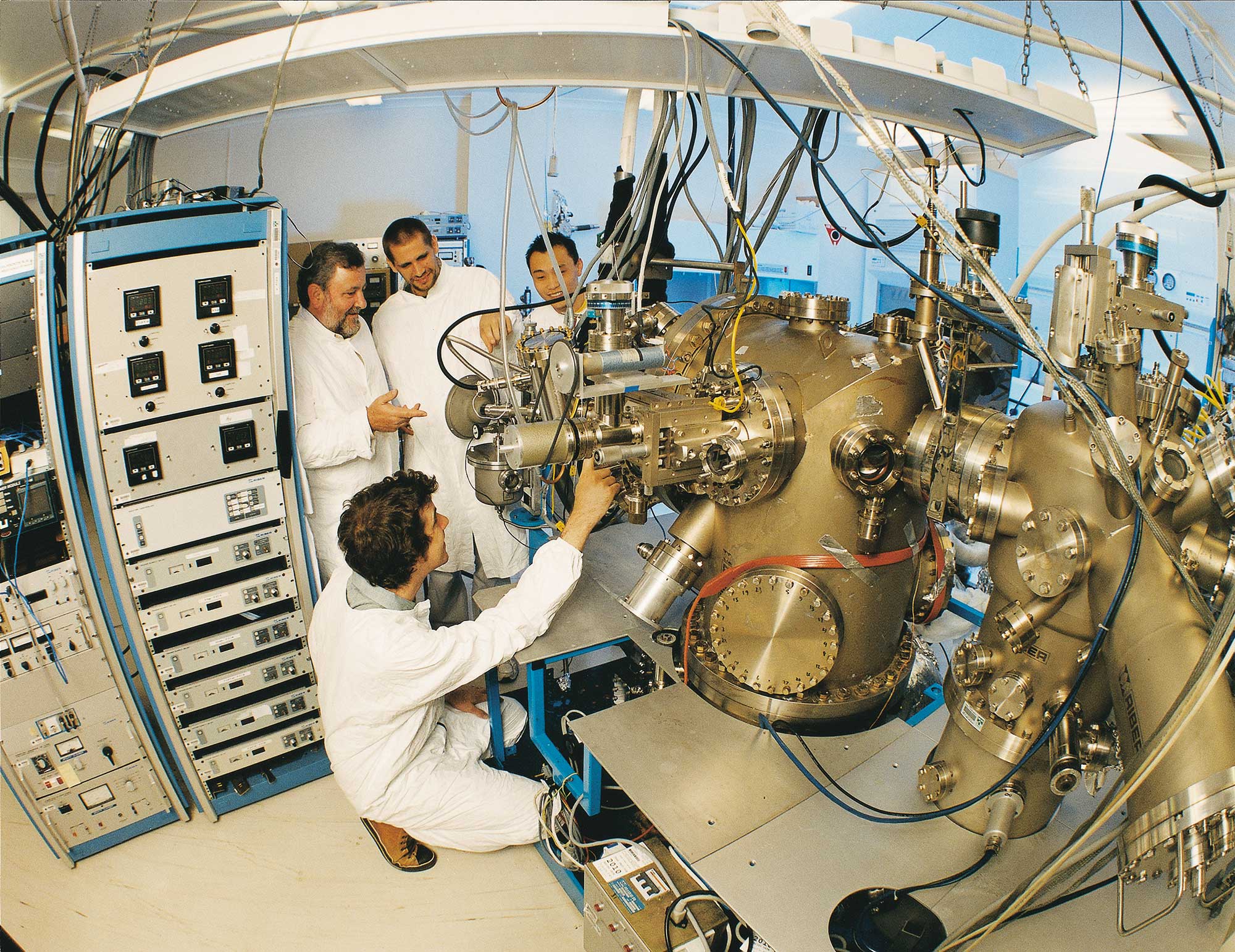
Deep Reactive Ion Etching (DRIE)
Deep Reactive Ion Etching (DRIE)
Deep Reactive Ion Etching (DRIE) is effectively an extension of the Reactive Ion Etching (RIE) process, but can provide higher aspect ratio structures.The DRIE process alternates between etch and passivation cycles to allow patterns to be cut deeper into a substrate.Etch channels or other feature geometries with extremely high uniformity into glass, plastic or silicon substrates

List of available equipment
TOOL MAKE AND MODEL
KEY DIFFERENTIATOR
LOCATION
Oxford Instruments Plasmalab 100 ICP380 – Silicon-specific dry etching
Deep reactive ion etcher (DRIE) capable of Bosch process
Melbourne Centre for Nanofabrication
VIC Node
Description
Silicon-specific dry etching with good control over feature size and Bosch process capability for high aspect ratio structures.
Related Information
SF6 gas is turned in to a plasma using RF power. The plasma that is created is highly reactive to Silicon. The SF6 combined with a passivating chemistry using C4F8, which is used to control the Silicon etching profile.
Tool Contact
mcn-enquiries@nanomelbourne.com
Oxford Instruments Plasmalab 100 ICP380 DRIE setp
Deep reactive ion etcher (DRIE)
Melbourne Centre for Nanofabrication
VIC Node
Description
General dry reactive etching of wide range of materials.
Related Information
Reactive species and ions are used to react with the substrate that is placed in the reactor to etch Si, SiO2, SI3N4, SiC, a-Si, Ti, TiW, Mo, Nb, Ta, Graphene and other 2D materials, Cr, Au, LiNbO3, Al, Al2O3, Hf, Hf02, TiN, TiO2, and more.
Tool Contact
mcn-enquiries@nanomelbourne.com
Plasma-Therm Versaline
Deep reactive ion etcher (DRIE)
QLD Node
University of Queensland
Description
Controlled dry anisotropic etching of silicon wafers up to 6 inches in diameter utilising the Bosch process. The deep silicon etching (DSE) process alternates between deposition and isotropic etching in a chamber with an ICP configuration.
Related Information
Etching of silicon only. The deposition gas is typically C4F8 and the etching gas is commonly SF6. Gases available: SF6, C4F8, argon and oxygen. Substrate is 6 inch wafer. Fast silicon etch rate of 3 - 5 µm/min with a deep vertical wall.
Tool Contact
anff@uq.edu.au
Ulvac NLD-570
Deep reactive ion etcher (DRIE)
SA Node
University of South Australia
Description
Capable of deep etching features from the nano to micron scale.
Related Information
Etch channel or other feature geometries with extremely high uniformity into glass, plastic or silicon substrates.
Tool Contact
Simon.Doe@unisa.edu.au
TOOL MAKE AND MODEL
KEY DIFFERENTIATOR
LOCATION
Oxford Instruments Plasmalab 100 ICP380 – Silicon-specific dry etching
Deep reactive ion etcher (DRIE) capable of Bosch process
SA Node
University of South Australia
Description
Silicon-specific dry etching with good control over feature size and Bosch process capability for high aspect ratio structures.
Related Information
SF6 gas is turned in to a plasma using RF power. The plasma that is created is highly reactive to Silicon. The SF6 combined with a passivating chemistry using C4F8, which is used to control the Silicon etching profile.
Tool Contact
mcn-enquiries@nanomelbourne.com
TOOL MAKE AND MODEL
KEY DIFFERENTIATOR
LOCATION
Oxford Instruments Plasmalab 100 ICP380 DRIE setp
Deep reactive ion etcher (DRIE)
SA Node
University of South Australia
Description
General dry reactive etching of wide range of materials.
Related Information
Reactive species and ions are used to react with the substrate that is placed in the reactor to etch Si, SiO2, SI3N4, SiC, a-Si, Ti, TiW, Mo, Nb, Ta, Graphene and other 2D materials, Cr, Au, LiNbO3, Al, Al2O3, Hf, Hf02, TiN, TiO2, and more.
Tool Contact
mcn-enquiries@nanomelbourne.com
TOOL MAKE AND MODEL
KEY DIFFERENTIATOR
LOCATION
Plasma-Therm Versaline
Deep reactive ion etcher (DRIE)
SA Node
University of South Australia
Description
Controlled dry anisotropic etching of silicon wafers up to 6 inches in diameter utilising the Bosch process. The deep silicon etching (DSE) process alternates between deposition and isotropic etching in a chamber with an ICP configuration.
Related Information
Etching of silicon only. The deposition gas is typically C4F8 and the etching gas is commonly SF6. Gases available: SF6, C4F8, argon and oxygen. Substrate is 6 inch wafer. Fast silicon etch rate of 3 - 5 µm/min with a deep vertical wall.
Tool Contact
anff@uq.edu.au
TOOL MAKE AND MODEL
KEY DIFFERENTIATOR
LOCATION
Ulvac NLD-570
Deep reactive ion etcher (DRIE)
SA Node
University of South Australia
Description
Capable of deep etching features from the nano to micron scale.
Related Information
Etch channel or other feature geometries with extremely high uniformity into glass, plastic or silicon substrates.
Tool Contact
Simon.Doe@unisa.edu.au
